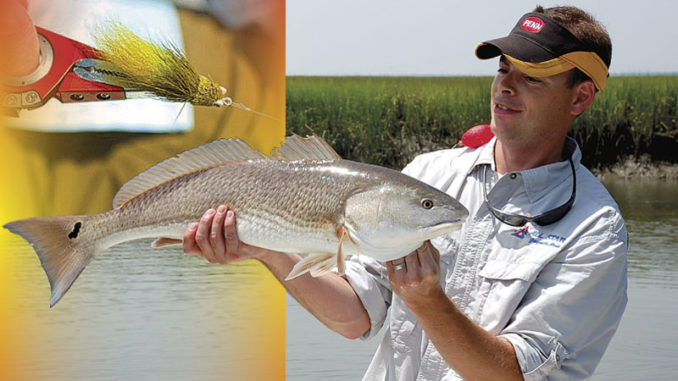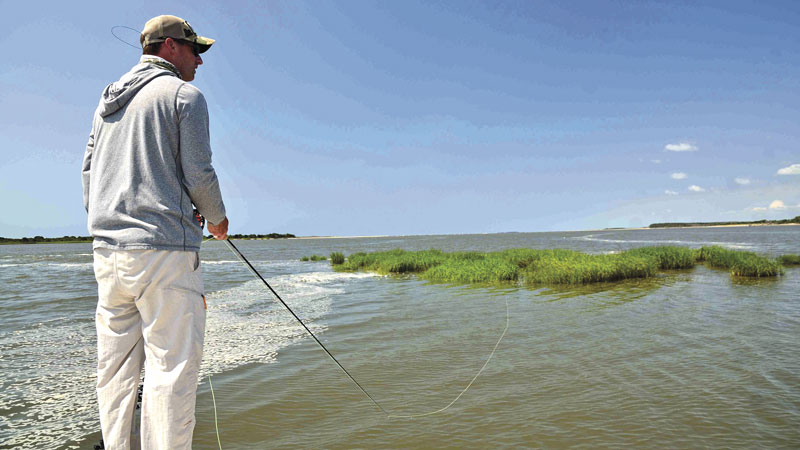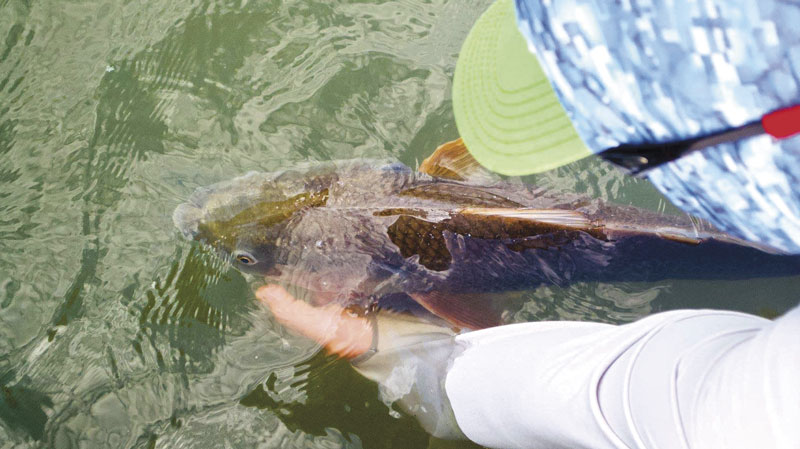
Take these tips for catching summer redfish on fly-fishing tackle; the Georgetown, S.C., area is a great place to put them into practice.
South Carolina is a southern jewels that permits anglers to chase their passion 365 days per year, from freezing Februaries to sizzling summer days. It’s those hot, August days that green-light anglers to target redfish around Georgetown, S.C., not only with traditional spinning and casting outfits, but also with fly rods and flies crafted from exotic materials.
Reds adjust to summer’s heat, changing their daily routines to meet their needs. And anglers who can decipher those changes and find fish are a step ahead of the game.
Jeff Lattig of Living Water Guide Service in Pawleys Island, S.C., keeps close tabs on these fish all year, and as one of only a few licensed fly-fishing guides in the area endorsed by Orvis, he is an expert at targeting redfish with flies.
Weather and water conditions push Lattig to different areas in the waters around Georgetown, which stretch from North Inlet to Cape Romaine and Bulls Bay well to the south. The reason? redfish and baitfish respond to changes in salinity.
Rain determines the best fishing spots
“Rain is a big factor in summer,” Lattig said. “When we are receiving heavy rains, we will fish closer to the inlets where less freshwater is present. And during periods of dry weather, we will fish back in the bays more.”
Redfish also battle the summer’s heat by leaving the most-extreme, shallow waters for deeper, cooler waters in the same basic areas. So instead of heading well up in tidal creeks, he’ll short-stop his travels to intercept reds in summer pinch points.
“They come out of shallow creeks when it gets hot and hold at creek mouths on an oyster point or grassy point,” Lattig said. “They can still escape dolphins but get access to cooler water. Deeper creeks and moving water typically offer cooler conditions.”
Fish will move on a dime when conditions change. Changes of just a degree or two in water temperature can make a big difference.
“We traditionally get an early start in the summer and fish at first light. The water is a little cooler in the mornings, and the fish will turn on to feed at first light,” he said.

Start the day on top
Lattig begins his day with topwater offerings. The low light can set the stage for surface-feeding opportunities, especially when the tide is low and the fish are congregated around oyster bars close to creek mouths.
“Poppers and gurglers are the flies we begin with,” he said. “We cast to fish on oyster points at the creek mouths and on the grass edges. We fish the poppers with a stop-and-go retrieve but will keep the gurglers moving a little more. They need it working more than a popper, but they will crush them just like a traditional Spook.”
Lattig prefers to target reds around creek mouths on the low end of the tide. But he will venture back up the creeks as the tide begins to rise.
“On an incoming tide, you get a little temperature drop with some added clarity, too. These fish will work their way back up the creek following the bait and set up in the little, shallow ponds with broken grass,” he said.
During this sequence, Lattig will switch to subsurface flies that imitate larger finger mullet.
Match the hatch
“Reds are keyed on finger mullet,” he said. “I like larger-patterned flies on 2/0 hooks with a large profile that push more water, like a kinky muddler or any type of baitfish profile with some bulk to it. Spun deer hair (flies) with some bulk that move some water are my favorites.
“I tie a lot of my own patterns. But it’s hard to beat Enrico Puglisi Rattle Mullet. It has EP fibers, glass rattles and is just a meaty fly that is just what you need in these shallow ponds,” he said.
Lattig isn’t immune to traditional dredging techniques, either. When fish congregate in deeper pools and creek mouths at low tide, he will switch to an intermediate, sinking line and dredge heavy Clouser minnows with big, dumbbell eyes, bouncing them off the shell bottoms to trigger a strike.
“I like to cast upcurrent and let it float or sink downstream, and then strip it back,” he said “It’s a fantastic technique to energize reds in these holes and can wake up a speckled trout as well,” he said.
Destination information
HOW TO GET THERE — Georgetown is on US 17, south of the Grand Strand but far north of Charleston. Its waters are accessible from several public boat ramps: South Island Ferry southeast of town, the East Bay Park landing in downtown Georgetown, and the Campbell Marine Complex on the south end of the US 17 bridge across the Sampit River.
WHERE TO GO — Redfish make a living in the waters around Georgetown year-round, from North Inlet to Cape Romaine and Bulls Bay. Weather and water conditions steer anglers to the best summer spots. During periods of excessive rainfall, the North Inlet area and other areas near the ocean with little freshwater input are tops. During dry spells, fish are likely to be in the bays off Winyah Bay closer to the rivers, the Santee Delta and the Cape Romaine/Bulls Bay area. Look for tailing flats adjacent to areas that hold fish on low tide. When it’s hot, look at collection zones near deep waters over the shallow, tidal flats in the extreme backs of creeks with grass and oysters. Baitfish will congregate in the lower ends of creeks when the weather is cooler.
Essential info
BEST TECHNIQUES — Redfish can be duped by a wide variety of fly offerings. Poppers and gurglers are ideal in low-light conditions, because reds are keying on large finger mullet. Retrieve gurglers faster than poppers. After the topwater bite ends, an large baitfish pattern that pushes a lot of water will work, with an Enrico Puglisi Rattle Mullet being a favorite, retrieved in long, slow, steady strips. Best colors are black/purple and purple/gold. The mouth of deeper creeks are good spots to dredge with heavy Clouser minnows in white, chartreuse and pink. Use 9- to 10-foot fly rods in 8- to 10-weight with weight-forward, floating line and tapered leaders between 71/2 and 9 feet. For deeper water, go with an intermediate sinking line with a 4- to 5-foot leader. Leaders should be in the 20- to 25-pound class.
FISHING INFO/GUIDES — Jeff Lattig, Living Waters Guide Service, 843-997-4655, www.livingwaterguide.com. See also Guides & Charters in Classifieds.
ACCOMMODATIONS — Hampton Inn, Georgetown, 843-545-5000; Georgetown Area Visitors Center, www.visitgeorgetown.com; Myrtle Beach Area Convention and Visitors Bureau, www.mbchamber.com.
MAPS — Navionics, 800-848-5896, www.navionics.com; Capt. Segull’s Nautical Charts, 888-473-4855, www.captainsegullcharts.com; Delorme S.C. Atlas and Gazetteer, 800-561-5105, www.delorme.com.

Summer Reds: Handle with Care
Summer can offer fantastic fishing along the coast, from inshore players to offshore giants, but the hot water adds a new variable to consider, especially inshore on favorites such as speckled trout and redfish. Fish are more susceptible to injury in summer waters, especially in South Carolina,where inshore water temperatures can approach 90 degrees.
As water temperatures climb, fish become less durable. Anglers can still participate in catch-and-release fishing, but fish need to be retrieved quickly and returned swiftly to the water.
Guide Jeff Lattig of Living Water Guide Service in Pawleys Island, S.C., specializes in targeting redfish with fly tackle. And releasing healthy fish is a major part of his daily regimen.
“We practice catch-and-release fishing for redfish,” Lattig said. “To start off with, we use stout gear to get them in quickly.”
Lattig typically use an 8- or 9-weight rod for redfish and heavy, 20- to 25-pound, tapered leaders. The heavy tackle allows his anglers to make a good hookset and get the fish into the boat as quickly as possible.
Additionally, Lattig recommends wetting your hands before handling a fish and getting the fish back in the water as soon as possible to reduce stress.
Overworking a fish on the end of the line and in the boat during hot conditions can be a death sentence more ways than one. Not only can the added stress lead to death, the stressed fish can be very susceptible to predation from sharks and porpoises, especially when these fish are caught in deeper pools and places where larger predators exist. A 22-inch redfish would be nothing less than prime rib for a bull shark.

